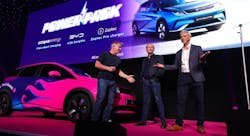EV Leap in the UK: Octopus Energy, China's BYD Unite for Bi-Directional Bundle Around Dolphin Model
Elevating the global rise of Chinese electric vehicle production, the United Kingdom’s largest energy supplier is joining forces with Chinese-based EV maker BYD to create Britain’s first vehicle-to-grid (V2G) product bundle for UK customers.
The Power Pack Bundle offered by Octopus Energy and BYD includes a leased V2G-ready BYD Dolphin EV, a bi-directional Zaptec Pro charger and access to a smart tariff that offers free home charging. The bundle is priced at 299 Euros per month (US$344) and will be available before the end of this year.
“Bi-directional charging is the game-changer for drivers and the grid,” Greg Jackson, founder of Octopus Energy Group, said in a statement announcing the Power Pack Bundle. “By using some of the battery’s spare capacity to help balance the grid, we can offer free driving. V2G is going to revolutionize our energy system and help drive costs down.”
Octopus announced the collaboration with BYD at its Energy Tech Summit this week in London. The power generation firm has more than six million customers across all of its territories.
BYD’s Dolphin model is a sub-compact EV which has close to 265 miles in battery range, 201 horsepower and can accelerate from 0 to 62 miles per hour in about seven seconds, according to the company. It is priced under $20,000 in U.S. dollars, although it’s not available in America yet and may not be for a while due to the trade war between U.S. President Donald Trump’s administration and China.
BYD Auto has been producing the hatchback Dolphin since 2021 and achieved pricing well below U.S. electric models. It is currently exported to markets in Europe, Australia, South America and southwest Asia.
Bidirectional and V2G technologies enable EVs to become “mobile microgrids” and create available distributed energy potential throughout power grids. BYD and Octopus Energy are partnering with Motability Operations, which is UK leasing company making the technology available to disabled people across the country.
“We’re thrilled to officially launch our V2G project with Octopus Energy and Kraken,” Stella Li, executive vice president of BYD, said. “Together with Octopus Energy, we’re enabling EV owners to play an active role in the energy ecosystem, reducing costs and increasing the resilience of renewable power systems.”
The United Kingdom has close to 1.2 million battery electric vehicles on its roads and adoption is growing there. EV sales have grown in the U.S., though recent moves to curtail incentives by the Trump Administration could impact that momentum.
Globally, EV adoption is rising throughout the world, with one in five automobiles sold being electric, according to the International Energy Agency’s Global EV Outlook. Chinese consumers are pushing EVs up to half of their vehicle transactions, while Norway is more than 90%, the IEA says.
The least expensive EVs in the U.S. include the Nissan Leaf, which starts at $29,000, according to Car and Driver. The most popular EVs in the U.S., according to US News and World Report, include the Tesla Models Y and 3, both of which are in the early $40,000 range.
The Global Battery Storage Race is On
Read more with this free EnergyTech E-Book
About the Author
Rod Walton, EnergyTech Managing Editor
Managing Editor
For EnergyTech editorial inquiries, please contact Managing Editor Rod Walton at [email protected].
Rod Walton has spent 17 years covering the energy industry as a newspaper and trade journalist. He formerly was energy writer and business editor at the Tulsa World. Later, he spent six years covering the electricity power sector for Pennwell and Clarion Events. He joined Endeavor and EnergyTech in November 2021.
Walton earned his Bachelors degree in journalism from the University of Oklahoma. His career stops include the Moore American, Bartlesville Examiner-Enterprise, Wagoner Tribune and Tulsa World.
EnergyTech is focused on the mission critical and large-scale energy users and their sustainability and resiliency goals. These include the commercial and industrial sectors, as well as the military, universities, data centers and microgrids. The C&I sectors together account for close to 30 percent of greenhouse gas emissions in the U.S.
He was named Managing Editor for Microgrid Knowledge and EnergyTech starting July 1, 2023
Many large-scale energy users such as Fortune 500 companies, and mission-critical users such as military bases, universities, healthcare facilities, public safety and data centers, shifting their energy priorities to reach net-zero carbon goals within the coming decades. These include plans for renewable energy power purchase agreements, but also on-site resiliency projects such as microgrids, combined heat and power, rooftop solar, energy storage, digitalization and building efficiency upgrades.

